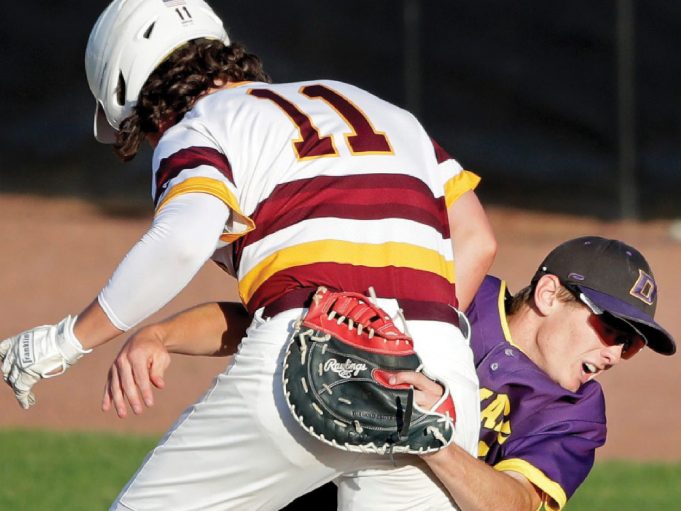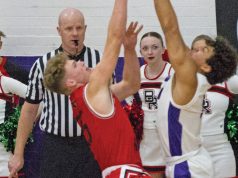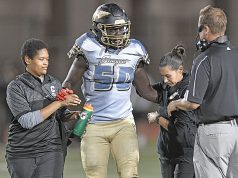So you think baseball is not a contact sport?
Look at the photo that accompanies this article, captured during the Wisconsin Interscholastic Athletic Association Division 2 state semifinals between Denmark High School and Jefferson High School this past June, and think again as you try to unravel what may have happened on this particular play. Such a big collision on any of the bases is certain to draw plenty of ill-informed reactions by the interested parties, and it’s up to you and your crew to use proper rules knowledge and mechanics to make an informed ruling that may not be popular, but correct nonetheless.
From a rules perspective, is this obstruction by the defense, with the first baseman cutting off access to the bag before he has the ball in his possession (NFHS 2-22-3; NCAA 2-55; pro Definition of Terms)?
Is it interference by the offense, either due to the batter-runner purposely making contact with the first baseman in an effort to jar the ball loose (NFHS 2-21-1a; NCAA 2-51a; pro Definition of Terms), or due to a runner’s lane violation as he runs inside the foul line during the final 45 feet between home plate and the first-base bag (NFHS 8-4-1g; NCAA 7-11p; pro 5.09.a.11)?
Regardless of who may be at fault, is this malicious contact on the baserunner according to NFHS rules (2-21-1b) or a violation of the NCAA collision rule that says a runner must make an actual attempt to reach the base (8-7a.1), may not attempt to dislodge the ball from a fielder (8-7a.2) and/or must attempt to avoid a collision if he can reach the base without colliding (8-7a.3)? And if it is a violation of any of the three NCAA provisions, again, is it flagrant or malicious?
From a mechanics perspective, if you are the first-base umpire on this play, are you putting yourself in a position to see all the necessary elements of this collision, or simply going through the motions related to a seemingly routine force play when all of a sudden this situation blows up on you? Are you aware of where the baseball is when the contact occurs? Did the first baseman complete the catch and then lose the ball due to the impact of the collision caused by the baserunner, or did he never have possession of the ball? Are you certain the batter-runner either has, or has not, touched first base?
As the plate umpire, are you coming up the first-base line and in a position where you can offer an opinion on the collision if asked? Are you ready to rule obstruction on the first baseman or runner’s lane interference if that’s what you have observed from your angle on the play?
Finally, both from a rules perspective and a mechanics perspective, the crew must understand this collision — whether illegal because of one of the many possibilities listed above, or a legal baseball play that happens to occur due to two players and the ball all arriving at the same place at the same time — is only one small part of the story. Because the inevitable follow-up question is: What happens next?
Is there activity on this play that requires the ball to become dead, either immediately or delayed once the playing action comes to a stop? If the ball remains live, what is the aftermath of this collision? Does the first baseman obstruct the batter-runner and prevent him from trying to advance to second base? Does the batter-runner interfere with the first baseman’s ability to freely move and secure the baseball?
And speaking of the ball, what if it ends up in dead-ball territory following the collision? Is it due to the throw itself? Is it because it was dislodged after being caught, making it the second act on the play? Does the base award differ if it’s one instead of the other?
Rules committees at all levels in recent years have taken great pains to try to remove unnecessary contact from the game. Whether it’s the aforementioned collision rule, the pro version for plays at home plate, or the force-play slide rule that has become such an omnipresent part of the game at the NFHS and NCAA levels, efforts are constantly being made to protect players and to give umpires rules to enforce to help that cause.
And still, a train wreck often occurs. When it does, the umpiring crew must know what’s OK, what’s not and the proper places to be on the field to make sure everyone has a clear look at the action so it can be properly adjudicated.
What's Your Call? Leave a Comment:
Note: This article is archival in nature. Rules, interpretations, mechanics, philosophies and other information may or may not be correct for the current year.
This article is the copyright of ©Referee Enterprises, Inc., and may not be republished in whole or in part online, in print or in any capacity without expressed written permission from Referee. The article is made available for educational use by individuals.
















